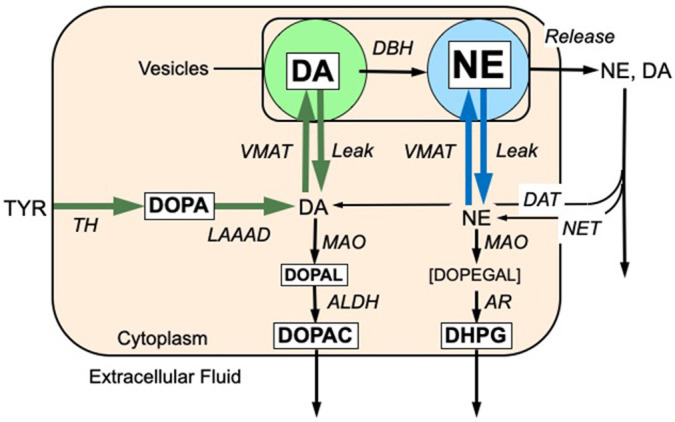Fig. 1.

Concept diagram showing enzymatic steps in the synthesis, vesicular storage, release, reuptake and metabolism of dopamine (DA) and norepinephrine (NE). The six endogenous catechols (in white rectangles) were measured simultaneously. DA is synthesized in the neuronal cytoplasmic via tyrosine hydroxylase (TH) acting on tyrosine to form 3,4-dihydroxyphenylalanine (DOPA) and then L-aromatic-amino-acid decarboxylase (LAAAD) acting on DOPA. Most of cytoplasmic DA is taken up into vesicles via the vesicular monoamine transporter (VMAT) but a minority undergoes enzymatic oxidation catalyzed by monoamine oxidase (MAO) to form 3,4-dihydroxyphenylacetaldehyde (DOPAL). DOPAL is metabolized by aldehyde dehydrogenase (ALDH) to form 3,4-dihydroxyphenylacetic acid (DOPAC), which exits the cell. DA in the vesicles undergoes enzymatic hydroxylation by DA-beta-hydroxylase (DBH) to form NE. Catecholamines released into the extracellular fluid is taken back up into the cytoplasm via the cell membrane DA transporter (DAT) or NE transporter (NET). NE in the cytoplasm can undergo vesicular uptake or MAO-catalyzed oxidative deamination to form 3,4-dihydroxyphenylglycolaldehyde (DOPEGAL), which is reduced by aldehyde/aldose reductase (AR) to form 3,4-dihydroxyphenylglycol (DHPG). DHPG rapidly exits the neuron. Font sizes correspond roughly to tissue concentrations of the analytes in rat striatum.
